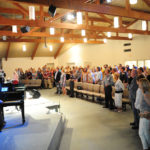RALEIGH, N.C. (ABP) —Pullen Memorial Baptist Church, which celebrates its 125th anniversary in 2009, is turning heads with a new eco-friendly building addition that eases overcrowding, allows for expanded missions and establishes a strong architectural presence along a prominent business and cultural thoroughfare in Raleigh, N.C.
On Feb. 1, the church dedicated a metal-shingled 9,800- square-foot addition affectionately nicknamed the “shiny diner” tied in with Pullen’s original brick-and-mortar sanctuary built in 1923.
“We’ve been holding Sunday school in the hallways for more than 15 years, so it was clear the church needed a solution,” said Nancy Petty, the church’s co-pastor.
|
Pullen Memorial Baptist Church is turning heads in Raleigh, N.C., with a new eco-friendly building addition.
|
More than 200 people have joined Pullen Memorial since 2000, according to the church website, bringing the church membership to 700 and active participants to more than 1,000.
Youth and children make up a large part of the growth. Youth Sunday school classes previously scattered throughout three floors now have their own classrooms alongside a new nonprofit Hope Center to minister to the community’s homeless, jobless and marginalized.
A 2003 master plan set goals of making the building more welcoming and accessible and expanding the church’s mission. “The more we discussed it, the clearer it became that we also wanted to have as ‘green’ a structure as we could,” said Regina Parham, chair of the church’s design and construction committee.
Building “as green as can be” while remaining affordable in a flagging economy provided a major challenge.
Since heating and cooling account for 30 percent of an average building’s energy consumption and power plant emissions contribute significantly to air pollution, Pullen Memorial opted for a geothermal heating, ventilation and air conditioning system.
Composed of 20 wells drilled to a depth of 375 feet to tap Raleigh’s average soil temperature of 64 degrees, the HVAC unit cost $170,000 more than a regular heat-pump unit, but church leaders believe the system, with a 50-year lifespan, will begin paying for itself after 10 years.
Sign up for our weekly edition and get all our headlines in your inbox on Thursdays
The system is expected to save $6,000 a year at current energy costs, and will stop more than 250,000 pounds of carbon emissions into the atmosphere—the equivalent of taking 22 cars off the road each year.
Other green features include orienting the building and placing windows to make best use of natural light. The design provides sunlight to 80 percent of the new space, including work and dining areas.
The addition also implements a “green roof”—covered with vegetation and soil over a waterproofing membrane—expected to reduce storm-water runoff, the No. 1 source of water pollution, by 25 percent. An underground cistern captures runoff from three areas, including the original church roof. The water will be used for landscape irrigation. Waterless urinals, dual-flush toilets and water-consider appliances will further cut water use and save costs.
Recycled building materials were used where possible. The wall and roof shingles are made from recycled metal and never will need painting, while flooring is made of renewable resources.
Pullen Memorial has a high-profile location on Hillsborough Street, a historic Raleigh thoroughfare viewed as a front door to North Carolina State University and corridor to the State Capitol, but primary access to the old building was from a smaller side street.
The new addition opens up access to Hillsborough Street, and a contemplation garden of preserved trees and replanted treasured flowers, shrubs and bushes, adds a touch of green space open to the public to a crowded urban space.
The addition also allows Pullen Memorial to expand services to the working poor, an emphasis that characterized the congregation at its founding in 1884. Created for people who fall through the gaps in social services, the Hope Center holds two offices for staff, a multipurpose space with computers to aid job-seekers, expanded space for tutoring and restrooms with showers and laundry facilities for the down and out.
New Raleigh magazine described the architecture as “simple,” “confident” and “sensitive.”
“This addition to a historic building melds the slope of the earth with new and redefined usable spaces,” the magazine said. “The lower story of the building addition cuddles up to the existing structure and acts to negotiate all of the elements of the project: a new chapel and fellowship hall, a roof garden, and a new entrance to the church. A courtyard space outside of the original sanctuary on the Cox Avenue side continues around to the rear of the building and becomes the vegetative roof of the new spaces. This exercise in placemaking yields an elegant transition that weaves the building and its surrounding landscape into a singular architecture.”
Another conscious decision involved forgoing construction on undeveloped land. Instead of adding parking, Pullen Memorial members reduced their 28 parking spaces to 14, meaning most worshippers will continue to park at nearby businesses or on the street.
The new building cost $3.7 million. A three-year capital campaign raised $2.2 million in gifts and pledges. An unexpected bequest in 2008 left just 20 percent of total costs to be financed with a bank loan.














We seek to connect God’s story and God’s people around the world. To learn more about God’s story, click here.
Send comments and feedback to Eric Black, our editor. For comments to be published, please specify “letter to the editor.” Maximum length for publication is 300 words.